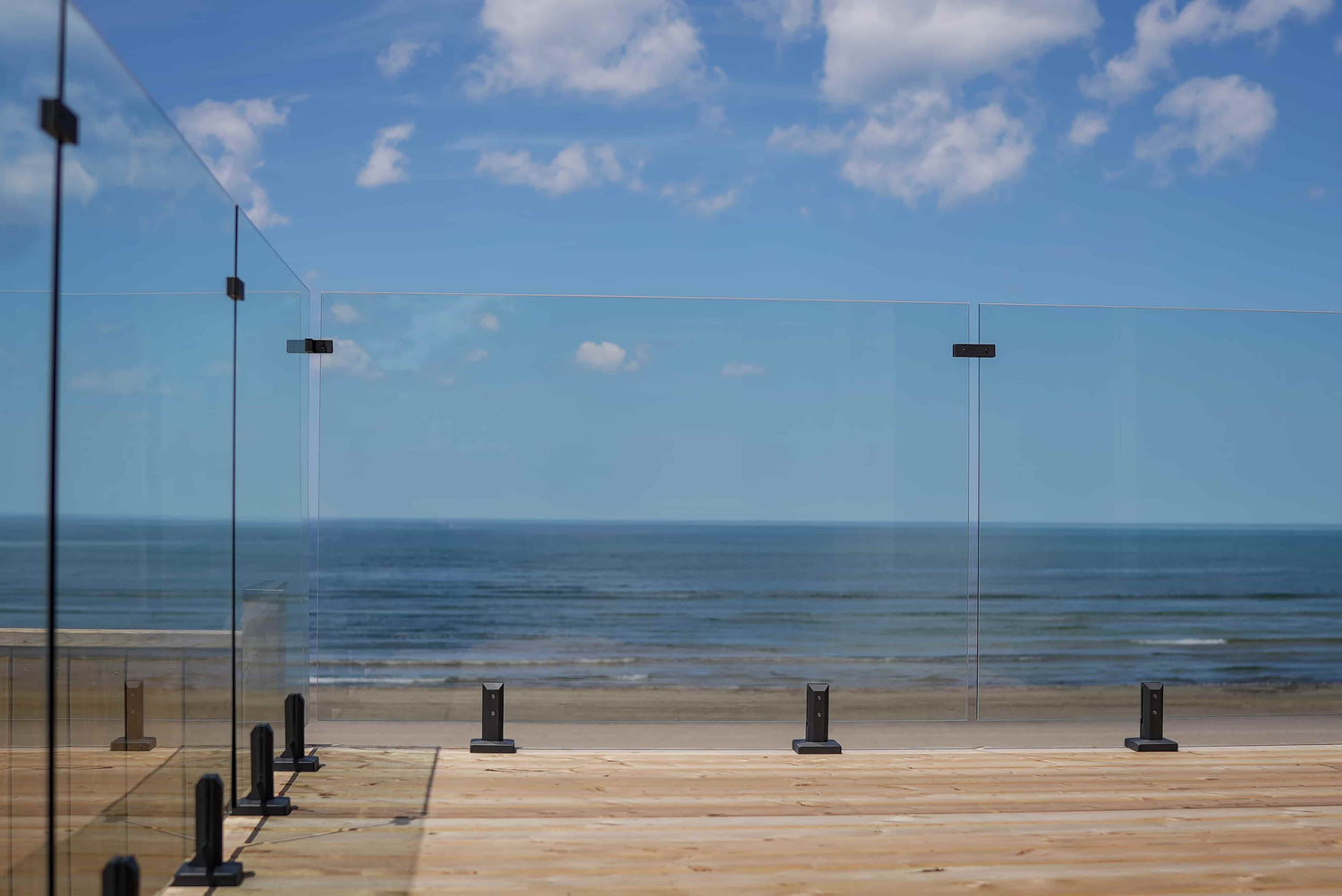Ohio Glass Building Code for Glass Railings

Glass railings are a signature feature in modern architecture, bringing style and transparency to both residential and commercial projects. In Ohio, cities like Columbus, Cleveland, and Cincinnati are seeing a growing trend in glass railing installations for decks, balconies, staircases, and interior spaces. However, installing these systems comes with strict code requirements that are essential to meet. These regulations exist not only for legal compliance but also for user safety and long-term durability. Whether you’re an architect, builder, or DIY homeowner, knowing Ohio’s latest glass railing codes will help you avoid project delays and costly rework.
What Codes Are in Force in Ohio?
As of March 1, 2024, Ohio officially enforces the 2024 Ohio Building Code (OBC). This code aligns with the 2021 International Building Code (IBC) and provides guidance for commercial and multifamily structures. For residential buildings, including single-family homes and townhouses, the state continues to follow the 2019 Residential Code of Ohio (RCO), which is based on the 2018 International Residential Code (IRC).
Understanding which code applies to your project is crucial for compliance. A downtown apartment building falls under the OBC standards. A suburban home addition, on the other hand, is governed by the RCO. These codes dictate everything from minimum guardrail height and opening dimensions to glass type, structural performance, and load-bearing requirements.
You can explore the official Ohio code documents here:
- Ohio Board of Building Standards – 2024 Code Update Summary (PDF)
- Residential Code of Ohio – Effective July 1, 2019
Key Residential Railing Requirements Under the RCO
In homes and low-rise residential structures, safety is paramount. Ohio’s RCO outlines specific provisions for guardrails and handrails, especially when using glass. Here’s what homeowners and contractors need to keep in mind:
- Guardrails are mandatory when a surface is more than 30 inches above the adjacent grade.
- Minimum guard height must be 36 inches.
- Stair handrails must be between 34 and 38 inches.
- Gaps between balusters or panels cannot exceed 4 inches.
- Glass must be either tempered or laminated safety glass.
Frameless systems, popular for their clean and uninterrupted views, are permitted only with laminated glass. Laminated glass holds together after breaking and offers superior safety. These systems usually require documentation or an engineer’s certification to prove performance. In contrast, tempered glass may only be used with a continuous top rail.
Homeowners seeking easier compliance can explore residential glass railing kits that are pre-engineered for RCO standards.

Commercial Compliance Under the Ohio Building Code (OBC)
Commercial buildings such as hotels, restaurants, and office spaces face more stringent standards under the 2024 OBC. Glass railing systems in these environments must not only protect against falls but also perform reliably under frequent use.
Key requirements include:
- Glass must comply with ANSI Z97.1 and CPSC 16 CFR 1201 safety glazing standards.
- Tempered glass installations must include a top rail. Laminated glass may omit the top rail if documentation supports post-break integrity.
- The system must resist a concentrated load of 200 lbs. and a uniform load of 50 lbs. per linear foot.
- All panels must display permanent labels showing manufacturer, glass type, and thickness.
- Custom systems or installations without typical support must be reviewed and approved through engineering analysis.
Review IBC Section 2407 for a complete breakdown of these regulations.
Additional Safety Requirements in Hazardous Locations
Ohio regulations also cover glass in hazardous locations. These are areas where broken glass may create a significant injury risk, such as near stairways, ramps, and walkways. According to Ohio Admin Code 4101:8-3-01, glass used in these areas must meet advanced glazing standards.
If a top rail is not included in the system, laminated glass is required. Builders must also provide engineering reports or manufacturer documentation confirming that the glass will hold together under impact. This requirement is particularly important in commercial and institutional buildings.
Residential vs. Commercial Requirements
|
Feature |
Residential (RCO 2019) |
Commercial (OBC 2024) |
|
Guard Height |
36 inches |
42 inches |
|
Stair Handrail Height |
34 to 38 inches |
34 to 38 inches |
|
Max Opening |
4 inches |
4 inches |
|
Glass Type |
Tempered or laminated |
Tempered or laminated |
|
Top Rail Required |
Required unless laminated |
Required unless laminated |
|
Load Resistance |
200 lbs. point load |
200 lbs. plus uniform load |
|
Labeling |
Not required |
Required |
|
Engineering Approval |
For frameless systems |
For nonstandard installs |
Common Pitfalls to Avoid in Glass Railing Projects
Even skilled professionals sometimes make critical errors in railing installations. These missteps can result in failed inspections and safety issues:
- Using annealed glass instead of code-approved safety glazing
- Omitting top rails on tempered glass installations
- Failing to provide documentation for laminated glass used without top rails
- Leaving openings wider than 4 inches between panels
- Installing glass without permanent labeling when required
- Skipping engineering documentation for frameless or unconventional designs
Contractors often avoid these problems by using pre-certified glass railing systems that meet code requirements.
Why Code Compliance Is Crucial
Code compliance serves both functional and safety purposes. Laminated glass helps retain the structure even after impact. Top rails offer backup safety in case of breakage. Consistent height and gap measurements protect children, pets, and anyone at risk of falling.
Inspectors across Ohio continue to enforce these codes with growing rigor. Preparing for inspections with a code-compliant system will save time and avoid unexpected delays.
Final Thoughts: Navigating Ohio’s Glass Railing Codes
Glass railing systems can elevate a building’s aesthetic while maintaining clear sightlines and enhancing safety. However, success with these systems depends on strict adherence to Ohio’s residential and commercial codes.
Consult engineers for complex or frameless systems. Choose laminated glass when top rails are not practical. Follow height, spacing, and load standards carefully.
To simplify your next project, explore glass railing systems designed for Ohio code compliance.
Frequently Asked Questions
1. What codes regulate glass railings in Ohio?
The 2024 Ohio Building Code (based on the 2021 IBC) regulates commercial properties. The 2019 Residential Code of Ohio applies to homes.
2. Can tempered glass be installed without a top rail?
No. Laminated glass is required when omitting the top rail. Tempered glass must include one.
3. Are permanent labels required on glass panels?
Yes, for commercial projects. Each glass panel must show labeling with manufacturer information and specifications.
4. Is annealed glass allowed in guardrail systems?
No. Only laminated or tempered safety glass is compliant.
5. Do I need engineering documents for all installations?
No, but they are necessary for frameless systems or designs without typical structural support.
Let customers speak for us

Glass Railing Near You
Discover how The Glass Railing Store has been delivering exceptional service to our customers, thanks to our dedicated and knowledgeable team and their love our glass railing products.







